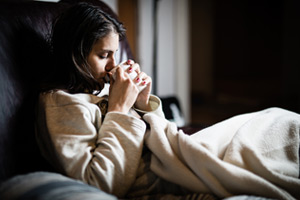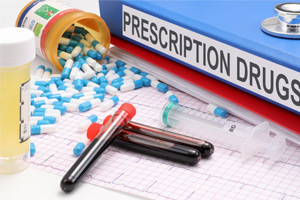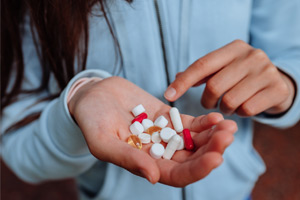What Is a Prescription Drug Rehab?
A prescription drug rehab is a specific type of rehabilitation that caters to individuals that have been abusing prescription or over-the-counter (OTC) drugs.
The National Institute on Drug Abuse (NIDA) defines prescription drug abuse as “the use of a medication without a prescription in a way other than prescribed, or for the experience of feelings elicited.”
Some prescription drugs can be addictive even when used as prescribed. A prescription for conditions including anxiety, ADD, pain, and other disorders can lead to tolerance and abuse relatively quickly. This is why access to quality prescription drug rehabs is essential.
A prescription drug rehab can be inpatient or outpatient, although it is suggested that the individual first attends an inpatient program. This is in part because prescription drug abuse can go undetected for extremely long periods as it becomes part of a person’s daily life.
If a person is in outpatient treatment it can be too tempting to say, “I have this under control,” then be unable to control the cravings and give into temptation. When there is more accountability, it becomes easier to stay off the pills and maintain a healthier lifestyle.
Who Suffers from Prescription Drug Abuse?
Prescription drug abuse – just like all other forms of substance abuse – does not discriminate by race, class, creed or socioeconomic background. This type of drug abuse could arise from a teenager getting into a medicine cabinet, being prescribed inappropriate drugs for a condition, or being prescribed a drug and not taking it as instructed.
Commonly abused prescription drugs include opiates such morphine, oxycodone and hydrocodone, stimulants such as methylphenidate and amphetamine, and benzodiazepines such as diazepam.

Treating Prescription Drug Addiction
Not so long ago, drug education was taught in schools in a very particular way – drugs are bad. Don’t use them at all, even if you think you won’t get addicted. Drugs like cocaine and heroin will destroy your life, and marijuana will start you on your descent into the life of a drug addict.
While that approach always had its problems, it is now completely redundant. Millions of drug addicts in the United States have never touched an illegal substance. They were not pressured into trying drugs by friends or other addicts. Rather, they were prescribed legal drugs by medical professionals.
Addiction to prescription drugs – opioid painkillers especially – has become an epidemic. No one is immune to it, no matter how careful they are to follow the law and make responsible decisions. When you’re in pain, you need relief, and opioids are often the “easiest” solution.
All drug addiction has multiple components. There is the dependence on the substance itself, then there’s the underlying reason the individual started using it. This is all the more evident in prescription drug addiction. The physical reason for which the drug was initially prescribed needs to be treated, while the individual detoxes and learns to weather the cravings.
Treatment requires detox and rehab
Much like any other drug addiction, prescription drugs can cause a physical dependency that needs professional treatment. People who are addicted to prescription drugs must go through detox so that they can rid their systems of the chemicals that are perpetuating their addiction. Withdrawal from prescription drugs can be quite uncomfortable or even dangerous, so a detox clinic with medical staff on hand is necessary.
After detox, a stay in rehab is the next important step to recovery because it will allow an individual to address their mental addiction as well. Rehab can help people turn their lives around and prevent a relapse.
Here is what to expect when you or a loved one begin treatment for prescription drug addiction.
Detox

The first stage of treatment is detoxification from the substance. This is the period in which the substance is purged from your body, breaking the physical need to use. Detox needs to be done in a controlled environment with medical professionals on hand. Doing it alone is dangerous for a number of reasons.
In the first place, no matter how good your reasons for detoxing are, the physical effects of withdrawal may drive you to use the substance again before it is completely eliminated. Few people can weather that storm.
Secondly, your body has come to rely on the substance. Without it, physical processes may begin to break down. Detox therefore needs to be done in a considered and measured fashion. Professionals experienced with substance abuse will determine a program according to which you’ll detox, making sure you don’t withdraw too quickly.
There can also be effects of withdrawal that could be indirectly dangerous. For example, vomiting and diarrhea can dehydrate the individual.
Medications

In many cases, rather than withdrawing from substances completely, professionals will prescribe alternative medications to help detox and recover. These can prevent withdrawal effects, as well as prevent further cravings.
It is helpful for patients who are severely addicted to prescribed drugs to take medication early in the course of treatment to alleviate withdrawal symptoms.
Opioid alternatives
The most common medication used to treat opioid abuse is methadone, which itself is a synthetic opioid. Buprenorphine, a partial opioid agonist which partially activates the opioid receptors, is also commonly used.
The common belief that this simply replaces one addiction with another is based on a misunderstanding of what these drugs do. They do not produce a high, but rather provide the balance the body is missing when the abused substance is taken away. They help the individual stay healthy so that they can recover from the physical and mental symptoms of addiction.
Naltrexone is another common medication used to treat opioid addiction. It prevents other opioids from binding to opioid receptors, so that the abused substance can no longer have any real effect. Some people take naltrexone injections which are long-acting and help prevent relapse for a period of months.
Sedatives, tranquilizers, and hypnotics
Withdrawals from sedatives and tranquilizers can also be dangerous for people addicted to these substances. Detox should be carried out gradually, and in the hands of a medical professional. At present, there are no medications which can help individuals detox, although research on the subject is ongoing.
Coping Mechanisms for Substance Abuse
A lack of adequate coping mechanisms is one of the common reasons that people turn to substances. When it comes to prescription drugs, there is almost always an actual need being addressed, including pain relief and relief from insomnia.
Simply withdrawing from the substance therefore cannot be the only form of treatment. Behavioral therapy provides the opportunity to create new, more effective, coping mechanisms.
Counseling

Individuals suffering with all kinds of substance abuse find counseling helpful.
Counseling helps them identify the underlying problems and talk through them. When it comes to prescription drug abuse, the underlying cause is generally already known, and is not necessarily connected to psychological factors.
However, psychological issues can form while the person is addicted to the substance.
Cognitive-behavioral therapy (CBT)
Cognitive-behavioral therapy (CBT) is one of the most common substance abuse treatment programs. CBT can help identify triggers that lead to drug abuse. It can help individuals rewire their associations with the substance and find new, more effective ways of coping. They learn that they do not need the substance and explore how they can function in a healthy way without it.
Mindfulness
What if the problem for which the drug was initially prescribed still persists? This is often true in cases of chronic pain or insomnia.
Mindfulness is an effective and popular way of managing chronic pain. It trains individuals to reconsider their associations with pain so that it is no longer as frightening. They can learn to ride the wave of the pain, watching it ebb and flow, recognizing that it is not always at full intensity and that when it is, the feeling will not last forever.
When used in conjunction with CBT, as well as non-addictive medications that can lessen the pain, mindfulness-based techniques are very effective.
Regarding insomnia, CBT techniques can be used to test the assumptions that may exacerbate the problem. Mindfulness-based techniques can help individuals fall asleep, as well as train them not to panic when sleep evades them.
Things You Should Know About Prescription Drug Addiction
Prescription drug abuse has become a major problem in the U.S., with painkiller misuse reaching epidemic levels in recent years. One of the important ways to combat this problem is to help people become more educated about the dangers of prescription drug addiction. Unfortunately, many people are unaware of the problems that can occur when using prescriptions for anxiety, pain or sleep medication.
It is important for everyone to learn more about prescription drugs because many Americans are prescribed medication and unintentionally become addicted. Others may use prescription drugs for non-medical reasons believing them to be safe simply because they are legal. With all of the myths and misconceptions about prescription drugs, it is crucial for people to familiarize themselves with the true facts.
Prescription drugs are the leading cause of fatal overdose

Overdoses have become an insidious problem in the U.S., particularly overdoses from opioid painkillers which cause about 45 deaths a day. Overdose deaths have reached unprecedented rates in the past decade as more people become addicted to prescription drugs. The number of prescription overdose deaths is now greater than the number of deaths from heroin and cocaine combined.
The situation continues to become more dire as painkiller related deaths continue to rise. These deaths increased from about 4,000 in 1999 to 16,600 in 2010 meaning that in just over a decade, overdose deaths from painkillers more than quadrupled. The numbers are staggering and only continue to grow as the problem worsens.
Prescriptions can cause tolerance and withdrawal
One of the tell-tale signs that indicate that someone has developed an addiction is when they start to develop a tolerance to a certain drug. Most people start to develop a tolerance to alcohol and need to drink more and more of it over time to feel drunk. Although some people may mistakenly believe that you can’t develop a tolerance to prescription medications, the reality is that many people do.
Once someone needs to take a higher dose of a medication to get the same effects, it signifies the early stages of addiction. Long-term prescription drug use can also lead to withdrawal symptoms, another clear sign that you are addicted. People who don’t get their regular dose of medication may experience feelings of nausea, headaches, irritability and other typical withdrawal symptoms.
Numerous types of medications are addictive

While opioid prescriptions may be the one of the biggest problems in the U.S. currently, they are not the only prescription drug that can lead to addiction. Other common types of prescription addiction can come in the form of stimulants such Ritalin and Adderall, benzodiazepines like Xanax and Valium used for anxiety, and sleep medications such as Ambien and Sonata. These are all types of medications that can cause tolerance, withdrawal and overdose.
Opioids are the most addictive type of prescription drug but people who are prescribed medication for insomnia or anxiety can easily become addicted. It is very common for people to abuse stimulants in order to have increased energy and focus for important projects at work or in school. Unfortunately, many young people become addicted to stimulants while they are using them in college to study.
Prescription addiction can have warning signs
There are certain ways to tell if someone in your life is struggling with an addiction to prescription drugs. You may notice changes in their behavior and physical appearance such as weight gain or loss as well as sleep changes. They also might seem irritable and depressed or seem to be having problems in work or school.
One common behavior that occurs when people are addicted to medication is doctor shopping or getting multiple prescriptions for the same drug. They may do this because they are taking more pills than their doctor has actually prescribed, and they need to maintain their supply. If someone seems to be seeing more than one doctor, then this can be a clear sign of a problem.
Prescription drug abuse is a major epidemic in the United States and around the world. With appropriate care, including detox, medication, and therapeutic interventions, it can be overcome successfully.
If you or someone you know is struggling with a prescription drug addiction, find a treatment center today.




